 Long before #Occupy was a hash tag, David White, an MFA candidate at UCSD’s school of Visual Arts, began to imagine an intensive arts-and- culture occupation of San Diego’s once shabby, now gentrifying North Park section. The neighborhood’s designation as an Arts District a decade earlier had done what such designations often do—encouraged a proliferation of hope-to-be hip bars and restaurants, while threatening to price out local artists and the small businesses that supported them. Looking to liberate the arts from price-per-square-foot, White and fellow Visual Arts students Jessica Sledge and Stephanie Lie planned an imaginative, low-rent alternative to the long running, North Park Festival of the Arts. Called There Goes the Neighborhood, and running for four days of June 2010, the new festival aimed at re-introducing North Park to itself.
Long before #Occupy was a hash tag, David White, an MFA candidate at UCSD’s school of Visual Arts, began to imagine an intensive arts-and- culture occupation of San Diego’s once shabby, now gentrifying North Park section. The neighborhood’s designation as an Arts District a decade earlier had done what such designations often do—encouraged a proliferation of hope-to-be hip bars and restaurants, while threatening to price out local artists and the small businesses that supported them. Looking to liberate the arts from price-per-square-foot, White and fellow Visual Arts students Jessica Sledge and Stephanie Lie planned an imaginative, low-rent alternative to the long running, North Park Festival of the Arts. Called There Goes the Neighborhood, and running for four days of June 2010, the new festival aimed at re-introducing North Park to itself.
In addition to featuring arts-fest staple—music performances and a poetry reading–the organizers focused on activist community-building. The Chicken Pie Shop, in business since 1938, was the site of a brunch and panel discussion on how to produce a community newspaper. San Diego artist Joe Yorty who makes collages from vintage wallpaper and vinyl and has memorialized the free sofas of Craig’s List in book form led a Saturday morning bicycle tour of North Park’s thrift stores.
Architect/Designer Megan Willis, whose installation Free Space: A street level look at interfaces between public and private was showing at the district’s Art Produce Gallery, offered a walking tour of actual spaces “strategically appropriated, reclaimed, and adapted by North Park residents.” Sites included a vacant lot repurposed as a skate park and a parking lot turned temporary market. The discussion turned on further repurposing, especially in the form of guerrilla gardens and arts spaces. The Arts Produce Gallery is itself an example of strategic space-use. A former produce mart, its glass front design allows exhibitions to be viewed from the sidewalk day and night, lighting a dark street as well as imaginations.
The festival’s anchor–-and to some extent model– was Agitprop, an actual and an electronic arts space White founded in 2007. With its gallery and studios carved out of space once used as storage by the adjacent grocery store, and its web links to academic, political and art world events, Agitprop embodied White’s idea that institutions should be embedded community networks, rather than intrusive or isolated edifices.
One example of networking in action: There Goes the Neighborhood ‘s opening night concert – Vibrating Milk, an act of “drawing with sound” performed by organizer Stephanie Lie– was held at San Diego Museum of Art. Those arriving early were invited to hear more music on a bus parked outside the museum. The bus was also the site of a literally moving concert by Bombshell, a group whose dedication to improvisation and audience participation includes making and/or discovering their own instruments.(Bicycle horns!) The moving part came as the bus shuttled riders to the openings at San Diego’s Museum of Contemporary Art in La Jolla and at downtown’s Sushi performance space.
Without big admission fees and booths of microbrew and jewelry for sale, how do you judge a festival’s success? Two walking tours on the agenda examined North Park yards and public spaces with an eye to food production. Art and Produce’s garden, begun in a parking lot the same year, now hosts a home-grower’s food exchange as well as garden-sited performances. Agitprop’s gallery reading series has expanded to include a summer salon at San Diego Museum of Art. But art-by-the-numbers took its toll as well. Sushi, home to edgy alternative arts since the 1980s is now closed.
White’s idea of institutions as fluid rather than static was pointedly articulated in a festival workshop, Given the question, could __be a classroom? museum? civic space?, participants were asked to fill in the blank. Results naming specific as well as generic locations were screened on tee shirts, washed at a local laundromat and worn to the evening performances. The questions still hover. Imagine a space occupied in a different way and you have already begun to transform it.
This just in: The second There goes the Neighborhood will take place May 31 to June 3, 2012. North Park is facing another source of transformation with the coming expansion of Interstate 805, and in acknowledgment, this year’s festival’s theme is “displacement.” White says he and the other organizers are not only thinking of the word’s negative connotations –“developers (both financial and cultural) displacing existing bodies from a particular locality”—but also of displacement in its contemporary intellectual sense as “a tool for creating interdisciplinary investigations, collaborations and dialogue.” This year, the tool will also come with instructions—a collaboration with the journal Pros which will not only be a festival history and events guide but a manual for other neighborhoods on how to create a similar celebration of community debate and engagement.
Ariel Swartley
San Pedro, CA
aswartley@att.net




